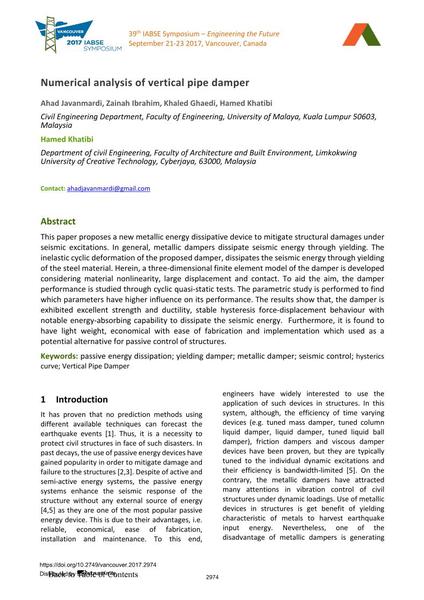Numerical analysis of vertical pipe damper

|
|
|||||||||||
Détails bibliographiques
| Auteur(s): |
Ahad Javanmardi
(Civil Engineering Department, Faculty of Engineering, University of Malaya, Kuala Lumpur 50603, Malaysia)
Zainah Ibrahim (Civil Engineering Department, Faculty of Engineering, University of Malaya, Kuala Lumpur 50603, Malaysia) Khaled Ghaedi (Civil Engineering Department, Faculty of Engineering, University of Malaya, Kuala Lumpur 50603, Malaysia) Hamed Khatibi (Civil Engineering Department, Faculty of Engineering, University of Malaya, Kuala Lumpur 50603, Malaysia) |
||||
|---|---|---|---|---|---|
| Médium: | papier de conférence | ||||
| Langue(s): | anglais | ||||
| Conférence: | IABSE Symposium: Engineering the Future, Vancouver, Canada, 21-23 September 2017 | ||||
| Publié dans: | IABSE Symposium Vancouver 2017 | ||||
|
|||||
| Page(s): | 2974-2980 | ||||
| Nombre total de pages (du PDF): | 7 | ||||
| Année: | 2017 | ||||
| DOI: | 10.2749/vancouver.2017.2974 | ||||
| Abstrait: |
This paper proposes a new metallic energy dissipative device to mitigate structural damages under seismic excitations. In general, metallic dampers dissipate seismic energy through yielding. The inelastic cyclic deformation of the proposed damper, dissipates the seismic energy through yielding of the steel material. Herein, a three-dimensional finite element model of the damper is developed considering material nonlinearity, large displacement and contact. To aid the aim, the damper performance is studied through cyclic quasi-static tests. The parametric study is performed to find which parameters have higher influence on its performance. The results show that, the damper is exhibited excellent strength and ductility, stable hysteresis force-displacement behaviour with notable energy-absorbing capability to dissipate the seismic energy. Furthermore, it is found to have light weight, economical with ease of fabrication and implementation which used as a potential alternative for passive control of structures. |
||||
